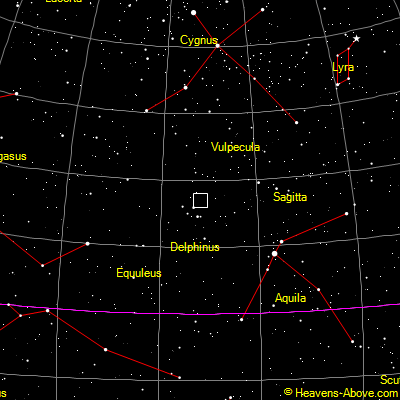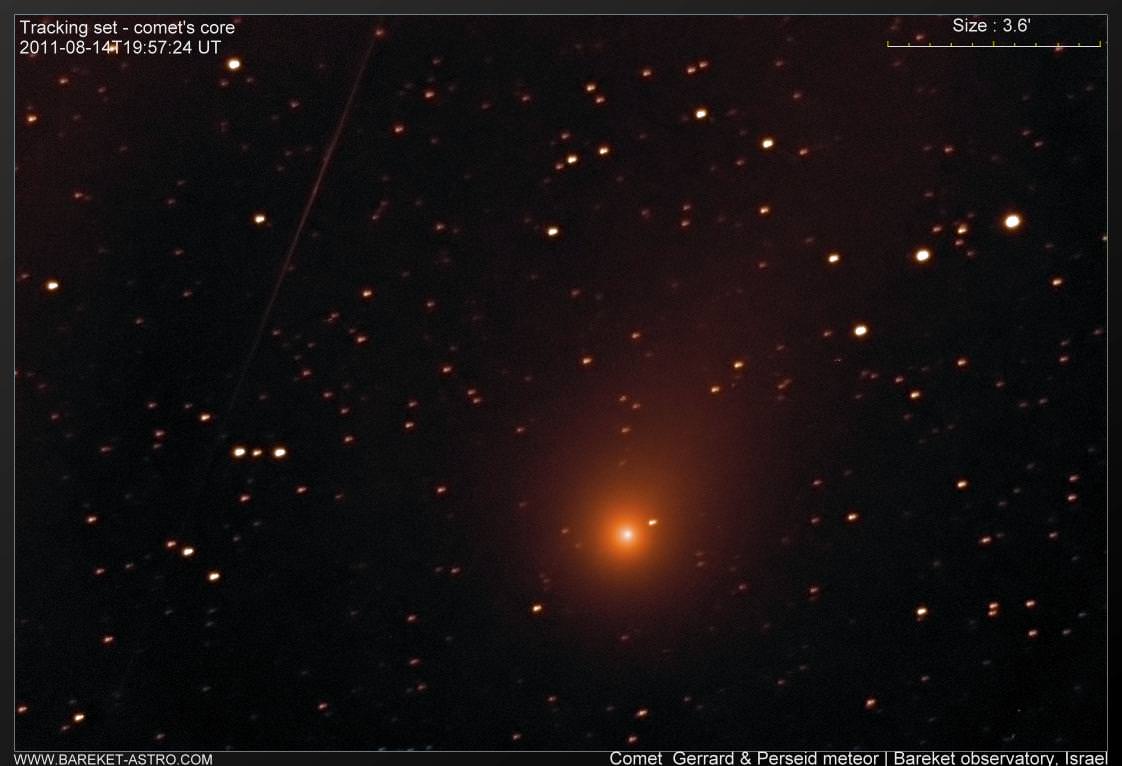[/caption]
What are you waiting for? If it’s an engraved invitation, then consider this your pass to get out and start looking for Comet C/2009 P1 Garradd! It’s well within reach of average binoculars and it’s even in a position that’s easy for the average observer! Step on out here into the backyard and I’ll show you…
 At close to magnitude 8, Comet C/2009 P1 Garradd is currently grazing its way along the eastern line of the Summer Triangle. Even if you live in a moderately light polluted area, you should be able to make out the three bright stars, Deneb to the north, Vega to the west and Altair to the south. Just aim your binoculars roughly halfway between Altair and Deneb and begin scanning on binocular field at a time for a faint, fuzzy poofball that signifies the comet’s presence. What you will see in binoculars will appear to be like a “fuzzy star” – while a telescope will reveal the beginnings of a tail.
At close to magnitude 8, Comet C/2009 P1 Garradd is currently grazing its way along the eastern line of the Summer Triangle. Even if you live in a moderately light polluted area, you should be able to make out the three bright stars, Deneb to the north, Vega to the west and Altair to the south. Just aim your binoculars roughly halfway between Altair and Deneb and begin scanning on binocular field at a time for a faint, fuzzy poofball that signifies the comet’s presence. What you will see in binoculars will appear to be like a “fuzzy star” – while a telescope will reveal the beginnings of a tail.
Just check out the video taken by our friends at Bareket Observatory!
Did you catch the signature of a Perseid meteor in there, too? Good for you!
Now quit messing around on the computer and get out there and capture that comet!
Thanks to Bareket Observatory for the images and to heavens-above.com for the locator chart!


Yo Tammy, at the first paragraph, in the second sentence: “[…], the consider this your pass […]”; that “the” should be then.
fixed.
i’m anxious to see what your impressions are. i was surprised at what i saw last night – so i kept returning over and over again to make sure i was looking at the same thing. i’d even defocus and refocus the binos again and again…
because i don’t want to influence anyone else’s opinion of what Garradd looks like in 10X50 binoculars, i won’t tell everything – but i will tell you that i was surprised at what i saw. readers? tell me what you see…
Well, Tammy, last night I could not see a bloody thing – thin clouds were obscuring the sky. Nuts!
It’s an omen.
i see a reddish glistening object just west of me in illinois, it risesjust after 2a.m. central time, could this be the comet? or just another star or planet?
It is most likely Antares, if it is rising around 2 am. You cannot see Garrad with the unaided eye at the moment
Antares sets around 11:40 p.m. So it can’t be Antares. The Summer Triangle is high in the west at 2:00 a.m. but it consists of blueish stars (Vega, Deneb and Altair) so it isn’t any of them. Mars rises in the northeast around 2:00 a.m. but it’s fairly faint (mag. +1.4) and too close to the horizon to see without binoculars. So… Shaun’s object remains a reddish glistening unknown.
If that reddish object is rising at 2:00 a.m., Illinois time, then it’s most likely to be the star Betelgeuse in the constellation of Orion.
My visual impression of this comet on the night of August 16, 2011 as viewed with 10 x 50 binoculars in light polluted yellow zone. I expected it would be difficult, but visible. Surprised that it was rather difficult. Not seen in my first attemps, confirmed much lower object M15 was visible in binoculars and higher M27 was also seen. Moon was low in sky, hidden by local terrain.
Returning to comet posistion, I eventually did see the very large dim diffuse coma. Mostly by using averted vision and knowing where to look. May have found it quicker without the moon in the sky. One must have darker skies to pick out this comet at this time. Future positions put in the richer star field region of the Milky Way.
I was able to located Comet Gerradd with a 8 x 50 finder on July 30, 2011 from a darker site, Promise Land State Park in Pennsylvania, and show it at a public viewing program to the attending people. Easy to locate that night, without the use of a chart just by knowing it was near Messier 15.
i’m really happy to see some comet comments here! what really impressed me was a sharp nucleus… almost stellar. (the weather hasn’t cooperated for me to return to verify that – but looks usually aren’t deceiving.) it also had perhaps 30-35″ of coma… and when my hands could hold steady long enough, i was picking up a short, stubby tail pointing towards the west/northwest.
best of luck to everyone and keep on observing!! 😀
All summer we did not have clear skys. But this evening I had one pass and went with my telescope 10″ dobsonian. Lot’s of haze and clouds but for a brief moment I saw this fuzzy thing when you did not look at it straight. I tried with binoculars but failed to see anything.
Had first view of Garradd with 10×50 bins when it was 2 fields to the right of M15. Could only just make it out, in relatively light polluted Herne Bay, Kent, England. On the night of the 26/27th August, I trained a 120mm short focus refractor on Sagitta and found Garradd with ease. Using an 88 degree fov, 4.7mm eyepeice, giving ~100x magnification, could see the stellar like nucleus and a sizable off-set coma. M71, the loose globular cluster was in the same fov and with averted vision it’s stars twinkled in and out of view. As M71 is magnitude 8.3 and Garradd considerably brighter due to its nucleus, it had to be at least magnitude 8 if not slightly brighter. I think this comet shows great potential and with an increase in brightness of a magnitude in less than 3 weeks who knows what might happen.
Do look out for it from November to January when it is either side of perihelion (December 23 2011) we might just have a Christmas Comet.
I found Garradd was very challenging to make out in 10×50 binoculars when passing to the right of M15 and not an object to enthuse beginners, shining at an estimated 9th Magnitude. Two weeks later on the night of the 26/27th Aug, it proved to be far more impressive, sharing the same fov as M71, the loose globular star cluster in Sagitta at 100x magnification.
Don’t bother looking for it now, unless you have an instrument with an aperture of at least 100mm or you will struggle to find it and it will not impress.
Perihelion (its closest approach to the Sun) occurs on the 23rd Dec. It should be at its most active and brightest in the run up to perihelion and then after, as it recedes from the Sun and approaches Earth (closest approach March 5th).
If it does get to its brightest around the 23rd December we will have a ‘Christmas Comet’ so keep an eye out for the inevitable hysteria about a second coming. Working at an observatory, the prospect fills me with dread, fortunately most of our visitors are intelligent of objective mind.
Still; an additional xmas pressy for us heathens:)